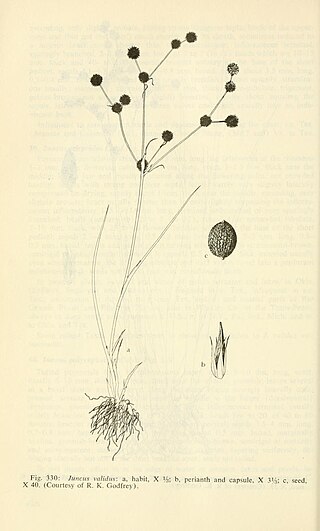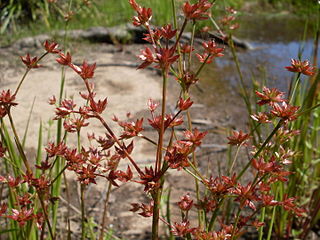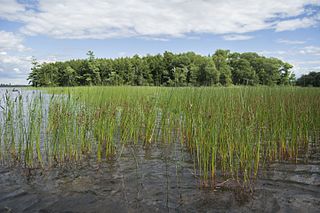
Juncaceae is a family of flowering plants, commonly known as the rush family. It consists of 8 genera and about 464 known species of slow-growing, rhizomatous, herbaceous monocotyledonous plants that may superficially resemble grasses and sedges. They often grow on infertile soils in a wide range of moisture conditions. The best-known and largest genus is Juncus. Most of the Juncus species grow exclusively in wetland habitats. A few rushes, such as Juncus bufonius are annuals, but most are perennials.

Juncus effusus is a perennial herbaceous flowering plant species in the rush family Juncaceae, with the common names common rush or soft rush. In North America, the common name soft rush also refers to Juncus interior.

Euryale ferox, commonly known as prickly waterlily, makhana or Gorgon plant, is a species of water lily found in southern and eastern Asia, and the only extant member of the genus Euryale. The edible seeds, called fox nuts or makhana when dried, are eaten in Asia.

Juncus bufonius, known commonly as toad rush, is a widespread flowering plant species complex in the rush family Juncaceae.

Juncus articulatus is a flowering plant species in the rush family Juncaceae. It is known by the common name jointleaf rush or jointed rush, which can also refer to J. kraussii from Australia. It is native to Eurasia, Canada, Greenland, and much of the United States. It grows in moist areas, such as wet sand, and thrives in calcareous soils. J. articulatus was found to be more sensitive to drought and salt stress than its congeners J. acutus and J. maritimus. It is a perennial herb producing mainly erect stems from a short rhizome. The stem may root at nodes, and it generally has one or more flattened hollow cylindrical leaves up to 10 centimeters long. Transverse internal partitions or joints may be seen or felt in the leaf of the plant.

Juncus acutiflorus, also called sharp-flowered rush, is a rush or a grassy plant of the genus Juncus. As the name suggests, the plant has notable sharp-looking flowers, flowering between July and September.

Juncus dichotomus is a monocot in the Juncaceae family of rushes. The plant is native to the Americas in temperate zones but has been introduced to other parts of the world. Juncus dichotomus often is found in very moist areas and where rainfall is a common occurrence. It is often most recognizable in the spring and summer months due to its conspicuous flowers and infructescence.

Juncus inflexus, the hard rush, is a species of flowering plant in the family Juncaceae, native to Europe, Asia and Africa, and introduced in Sri Lanka, Java, Île Amsterdam and Île Saint-Paul, Victoria in Australia, New Zealand, Uruguay, and eastern North America. It is a glycophyte (non-halophyte).
Juncus biglumis, called the two-flowered rush, is a species of flowering plant in the genus Juncus, native to the subarctic and subalpine Northern Hemisphere. It has three divergent genetic lineages that may represent cryptic species.

Oreojuncus is a small genus of flowering plants in the rush family Juncaceae, found in the eastern United States, eastern Canada, Greenland, Iceland, the Faroes, most of Europe, northern Russia, western Siberia and the Altai. Their chromosome number is 2n=30 (x=15), whereas Juncus, from which they were split, has x=20.

Juncus scirpoides, the needlepod rush, is a species of flowering plant in the family Juncaceae, native to the central and eastern United States. It prefers wet sandy soils, and among the many places it grows it is common in the enigmatic Carolina bays.

Juncus validus, the roundhead rush, is a species of flowering plant in the family Juncaceae, native to the central and southeastern United States. It is a somewhat weedy species, found along wet roadsides and in ditches.
Juncus fascinatus is a species of flowering plant in the family Juncaceae, native to Texas. Its specific epithet refers to Enchanted Rock, where it was first collected.

Juncus coriaceus, the leathery rush, is a species of flowering plant in the family Juncaceae, native to the southeastern United States, from Texas to Cape May, New Jersey. A report from New York state turns out to have been erroneous. A wetland species, it prefers poorly drained soils.

Juncus prismatocarpus, the branching rush, is a tufted, perennial species of flowering plant in the rush family, Juncaceae. Found in moist situations, often on sandy ground. Grass-like leaves are 10 to 40 cm long, 1.3 to 3.0 mm in diameter. Growing in many parts of Australia, New Zealand and south east Asia. The specific epithet is derived from Latin, meaning prism shaped fruit.

Juncus tweedyi, the narrow-panicled rush, is a species of flowering plant in the family Juncaceae. It is native to southern Canada, and the northern USA, extending down the mountain ranges. A perennial reaching 24 in (60 cm), it is typically found in wet areas, such as the edges of beaver ponds.

Juncus militaris, the bayonet rush, is a species of flowering plant in the family Juncaceae, native to eastern Canada and the eastern United States. A perennial, it is found in shallow lakes and slow-moving rivers, on a variety of substrates; sand, silt, and muck.

Juncus pelocarpus, the brown-fruit rush, is a species of flowering plant in the family Juncaceae, native to British Columbia and eastern Canada, and the north-central and eastern United States. A colonial perennial 1 to 12 in tall, it is found in wet areas.
Juncus papillosus, the papillose rush, is a species of flowering plant in the family Juncaceae, native to eastern China, the Korean Peninsula, Japan, and the southern part of the Russian Far East. A perennial 15 to 50 cm tall with terete stems and leaves, it is typically found in swampy meadows. Its chromosome count is 2n = 40.
Juncus fauriei is a species of flowering plant in the rush family Juncaceae, native to central Korea, central Japan, and the Kuril Islands. A perennial, it is found in wetlands, frequently in sandy soils near the coast. Its chromosome count is 2n = 80.















